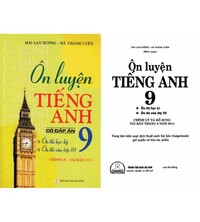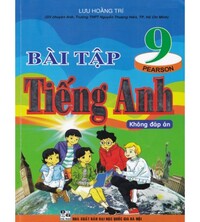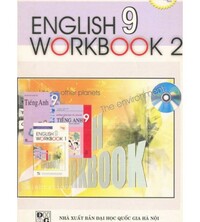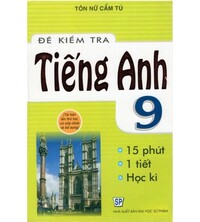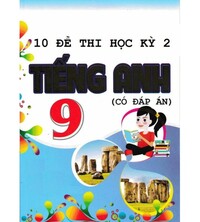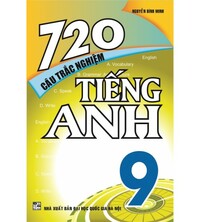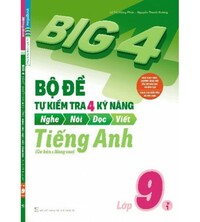Tiếng Anh 9 Unit 4 Getting Started
1. Listen and read. 2. Read the conversation again and answer the questions. 3. Complete each sentence with a word or a phrase from the box. 4. Look at the pictures and complete the sentences. 5. GAME. Remembering past events. Work in two groups. Give short answers to the following questions. The group with more correct answers wins.
Bài 1
At an English lesson
(Trong giờ học tiếng Anh)
1. Listen and read.
(Nghe và đọc.)
Teacher: Now let's look at what you've done on your projects. Group one first, please.
Mi: OK. This is Angkor Wat in Cambodia. It's a temple complex, the largest religious monument in the world.
Teacher: Fantastic! When did people build it?
Mi: They built it in the 12th century. It's a World Heritage Site. Millions of visitors go there every year.
Teacher: Thank you. I wish I could go there one day too. And now group two, please.
Nam: Our project is about Dinh Bang Communal House in Bac Ninh Province - a national historic site. People were building it for 36 years, and it's about 300 years old!
Teacher: Great! It's quite magnificent! Now group three, please.
Lan: Well, this is Windsor Castle in England. It was built about a thousand years ago. It's been the home for about 40 English kings and queens.
Teacher: Yeah. It's the oldest and largest occupied castle in the world.
Mi & Nam: Amazing! So we need to preserve our heritage for future generations.
Teacher: Right. Thanks to preservation efforts, we know a lot about our history and life in the past.
Phương pháp giải:
Tạm dịch:
Giáo viên: Bây giờ chúng ta hãy xem các em đã làm gì trong các dự án của mình. Mời nhóm một trước.
Mi: Vâng ạ. Đây là Angkor Wat ở Campuchia. Đó là một quần thể đền thờ, di tích tôn giáo lớn nhất thế giới.
Giáo viên: Tuyệt vời! Người ta xây dựng nó khi nào?
Mi: Họ đã xây dựng nó vào thế kỷ thứ 12. Đó là một di sản thế giới. Hàng triệu du khách đến đó mỗi năm.
Giáo viên: Cảm ơn em. Cô ước gì tôi cũng có thể đến đó một ngày nào đó. Và bây giờ xin mời nhóm hai.
Nam: Dự án của chúng em là về Đình Đình Bảng ở tỉnh Bắc Ninh - một di tích lịch sử quốc gia. Người ta đã xây dựng nó trong 36 năm và nó đã khoảng 300 năm tuổi!
Giáo viên: Tuyệt vời! Nó khá hoành tráng! Bây giờ xin mời nhóm ba.
Lan: Dạ, đây là Lâu đài Windsor ở Anh. Nó được xây dựng khoảng một ngàn năm trước. Đây là nơi ở của khoảng 40 vị vua và hoàng hậu Anh.
Giáo viên: Ừm. Đây là lâu đài bị chiếm đóng lâu đời nhất và lớn nhất trên thế giới.
Mi & Nam: Tuyệt vời! Vì vậy chúng ta cần phải bảo tồn di sản của mình cho thế hệ mai sau.
Giáo viên: Đúng vậy. Nhờ nỗ lực bảo tồn, chúng ta biết được nhiều điều về lịch sử và cuộc sống ngày xưa.
Bài 2
2. Read the conversation again and answer the questions.
(Đọc lại đoạn hội thoại và trả lời các câu hỏi.)
1. How old is Angkor Wat?
(Angkor Wat bao nhiêu tuổi?)
2. What is Dinh Bang Communal House like?
(Đình làng Đình Bảng như thế nào?)
3. Where is Windsor Castle?
(Lâu đài Windsor ở đâu?)
4. What helps us know about our history and life in the past?
(Điều gì giúp chúng ta biết về lịch sử và cuộc sống của mình ngày xưa?)
Lời giải chi tiết:
1. Angkor Wat is about 900 years old.
(Angkor Wat khoảng 900 năm tuổi.)
Thông tin:
Mi: OK. This is Angkor Wat in Cambodia. It's a temple complex, the largest religious monument in the world.
(Vâng ạ. Đây là Angkor Wat ở Campuchia. Đó là một quần thể đền thờ, di tích tôn giáo lớn nhất thế giới.)
Teacher: Fantastic! When did people build it?
(Tuyệt vời! Người ta xây dựng nó khi nào?)
Mi: They built it in the 12th century. It's a World Heritage Site. Millions of visitors go there every year.
(Họ đã xây dựng nó vào thế kỷ thứ 12. Đó là một di sản thế giới. Hàng triệu du khách đến đó mỗi năm.)
Giải thích: Hiện tại đang là thế kỉ 21 => số tuổi của đền Angkor Wat: thế kỉ 21 – thế kỉ 12 = 9 thế kỉ (900 năm)
2. Dinh Bang Communal House is a national historic site. It was built for 36 years, and it's about 300 years old! It's quite magnificent.
(Đình làng Đình Bảng là di tích lịch sử cấp quốc gia. Nó được xây dựng trong 36 năm và khoảng 300 năm tuổi! Nó khá tráng lệ.)
Thông tin:
Nam: Our project is about Dinh Bang Communal House in Bac Ninh Province - a national historic site. People were building it for 36 years, and it's about 300 years old!
(Dự án của chúng em là về Đình Đình Bảng ở tỉnh Bắc Ninh - một di tích lịch sử quốc gia. Người ta đã xây dựng nó trong 36 năm và nó đã khoảng 300 năm tuổi!)
Teacher: Great! It's quite magnificent! Now group three, please.
(Tuyệt vời! Nó khá hoành tráng! Bây giờ xin mời nhóm ba.)
3. Windsor Castle is in England.
(Lâu đài Windsor ở Anh.)
Thông tin: Lan: Well, this is Windsor Castle in England.
(À, đây là Lâu đài Windsor ở Anh.)
4. Preservation efforts help us know about our history and life in the past.
(Nỗ lực bảo tồn giúp chúng ta biết về lịch sử và cuộc sống của mình trong quá khứ.)
Thông tin: Teacher: Right. Thanks to preservation efforts, we know a lot about our history and life in the past.
(Đúng vậy. Nhờ nỗ lực bảo tồn, chúng ta biết được nhiều điều về lịch sử và cuộc sống ngày xưa.)
Bài 3
3. Complete each sentence with a word or a phrase from the box.
(Hoàn thành mỗi câu bằng một từ hoặc một cụm từ trong khung.)
|
occupied magnificent thanks to heritage well preserved |
1. The best way to preserve our cultural ______ is to share it with others.
2. Vietnamese people take great pride in their culture which has been ______ for thousands of years.
3. The foreign tourists gave a ______ performance of the Vietnamese folk songs and dances
4. ______ your kind contribution, we were able to save the ancient monument.
5. Many beautiful old castles are no longer ______.
Phương pháp giải:
- occupied (adj): có người ở
- magnificent (adj): hoành tráng
- thanks to + danh từ: nhờ có
- heritage (n): di sản
- well preserved (adj): được bảo tồn tốt
Lời giải chi tiết:
|
1. heritage |
2. well preserved |
3. magnificent |
|
4. Thanks to |
5. occupied |
|
1. The best way to preserve our cultural heritage is to share it with others.
(Cách tốt nhất để bảo tồn di sản văn hóa của chúng ta là chia sẻ nó với người khác.)
2. Vietnamese people take great pride in their culture which has been well preserved for thousands of years.
(Người Việt Nam rất tự hào về nền văn hóa được bảo tồn hàng nghìn năm.)
3. The foreign tourists gave a magnificent performance of the Vietnamese folk songs and dances.
(Du khách nước ngoài đã biểu diễn những làn điệu dân ca Việt Nam hoành tráng.)
4. Thanks to your kind contribution, we were able to save the ancient monument.
(Nhờ sự đóng góp tử tế của các bạn, chúng tôi đã có thể cứu được di tích cổ.)
5. Many beautiful old castles are no longer occupied.
(Nhiều lâu đài cổ xinh đẹp không còn người ở.)
Bài 4
4. Look at the pictures and complete the sentences.
(Nhìn tranh và hoàn thành câu.)
1. This is a standard serving of _______ with a slice of lemon.
2. The _______ house has a significant meaning in the Bahnar community.
3. In the square, there is a _______ dedicated to the people killed in the war.
4. They have decided to rebuild the _______ which was damaged in the disaster.
5. In Nam Dinh City, there is a complex of three _______ where people worship the Tran Dynasty's Kings and royal family members.

Lời giải chi tiết:
|
1. fish and chips |
2. communal |
3. monument |
|
4. castle |
5. temple |
|
1. fish and chips: cá và khoai tây chiên
This is a standard serving of fish and chips with a slice of lemon.
(Đây là khẩu phần tiêu chuẩn gồm cá và khoai tây chiên với một lát chanh.)
2. communal house (np): nhà rông
The communal house has a significant meaning in the Bahnar community.
(Nhà rông có ý nghĩa quan trọng trong cộng đồng người Bahnar.)
3. monument (n): đài kỉ niệm
In the square, there is a monument dedicated to the people killed in the war.
(Trong quảng trường có đài kỉ niệm tưởng nhớ những người đã thiệt mạng trong chiến tranh.)
4. castle (n): lâu đài
They have decided to rebuild the castle which was damaged in the disaster.
(Họ đã quyết định xây dựng lại lâu đài đã bị hư hại trong thảm họa.)
5. temple (n): ngôi đền
In Nam Dinh City, there is a complex of three temples where people worship the Tran Dynasty's Kings and royal family members.
(Ở thành phố Nam Định có quần thể ba ngôi đền thờ các vị vua nhà Trần và các thành viên hoàng tộc.)
Bài 5
5. GAME Remembering past events
(TRÒ CHƠI Nhớ lại những sự kiện đã qua)
Work in two groups. Give short answers to the following questions. The group with more correct answers wins.
(Làm việc theo hai nhóm. Đưa ra câu trả lời ngắn cho những câu hỏi sau. Nhóm nào có nhiều câu trả lời đúng hơn sẽ thắng.)
1. Who decided to move our capital from Hoa Lu to Dai La (Thang Long) in 1010?
(Ai quyết định dời đô từ Hoa Lư về Đại La (Thăng Long) vào năm 1010?)
2. When did Columbus discover the Americas?
(Columbus khám phá ra châu Mỹ khi nào?)
3. When was the United States founded?
(Nước Mỹ được thành lập khi nào?)
4. When did Nguyen Ai Quoc first go abroad?
(Nguyễn Ái Quốc ra nước ngoài lần đầu tiên vào năm nào?)
5. What happened in world history in 1914?
(Điều gì đã xảy ra trong lịch sử thế giới năm 1914?)
6. Who was the last king of Viet Nam?
(Vị vua cuối cùng của Việt Nam là ai?)
Lời giải chi tiết:
1. King Ly Thai To (Ly Cong Uan) decided to move our capital from Hoa Lu to Dai La (Thang Long) in 1010.
(Vua Lý Thái Tổ (Lý Công Uẩn) quyết định dời đô từ Hoa Lư về Đại La (Thăng Long) vào năm 1010.)
2. Columbus discovered the Americas in 1492.
(Columbus khám phá châu Mỹ năm 1492.)
3. The United States was founded on July 4, 1776.
(Hợp chủng quốc Hoa Kỳ được thành lập vào ngày 4 tháng 7 năm 1776.)
4. Nguyen Ai Quoc, first went abroad in 1911.
(Nguyễn Ái Quốc, ra nước ngoài lần đầu năm 1911.)
5. In 1914, World War I began.
(Năm 1914, Thế chiến thứ nhất bắt đầu.)
6. The last king of Vietnam was Bao Dai.
(Vị vua cuối cùng của Việt Nam là Bảo Đại.)
Search google: "từ khóa + timdapan.com" Ví dụ: "Tiếng Anh 9 Unit 4 Getting Started timdapan.com"
